Tesla Model 3’s motor – The Brilliant Engineering behind it
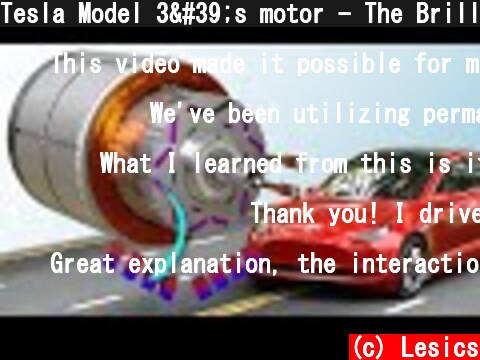
(c) Lesics The engineers of Tesla motor’s shocked everyone when they abandoned the versatile induction motor in Model 3 cars. They used …
This video made it possible for me to understand a little bit about electric cars, unlike anything I imagined. thank you very much
We’ve been utilizing permanent magnet rotors in motors in similar configurations for 100 years. Interesting that they are coming back around, while being tweaked for efficiency.
What I learned from this is if you ever have a problem in life, rotate it by 45° and if that doesn’t work, try 50°. Then, profit. 👍🏼
Thank you! I drive a 2019 Toyota Prius Prime, and this video is the best explanation I’ve ever found on how the cars two motor/generators work. One thing the video didn’t mention: there is a sensor on the rotor shaft of each of the Prius’s motors, that continually and very precisely tracks the angle of the rotor around it’s 360� circle. The signal from this sensor is fed to the motor control computer, which is controlling the bank of high-power MOSFET transistors in the inverter, that create the 3-phase alternating current that power the motor stator windings. As the video explains, there is an ideal phase-angle relationship between the magnetic fields in the rotor’s permanent magnets, and the phase angle of the rotating magnetic fields being produced by the stator. The motor control computer continually adjusts and optimizes this phase angle, based on the signal from the rotor position sensor, and other sensors, plus the driver’s demand for power given via the throttle pedal or cruise control setting. I assume that the Tesla, and other EV cars, have a similar sensor on the rotor.
Great explanation, the interaction between two different magnetic fields is never easy to visualize, but this video really makes the point!
The genius behind this is mind-boggling imho and I�m saying that as a technician. I�m continually amazed by what intricate designs human beings can come up with.
Great explanation. Makes you wonder why and when this style of power generation will be applied to the utilities industry and better yet, at the residential home level.
Thank you for this. The modeling is superb however I wish this video was longer to really explain the cooling and how the motors work in tandem. You are missing a conclusion that wraps everything up and a chance to add more detail. I’m sure you already know all of this. Again, great video! YouTube needs more people like you.
Looks exactly like the large servo motors we were using on a production line back in the 1990’s. They can accelerate like hell, decelerate the same and brake, and even stop at a selected position. We did not have high inertial loads on the output shaft which can create some of the issues discussed here. I don’t understand why the PM ‘servo’ wasn’t adapted sooner.
This is incredible!!! Could you imagine Tesla himself seeing this now? He’d be like, “Oh yes quite splendid, and mostly correct!”
Well done! Thanks for the high quality content, gentlemen
Person who designs and builds electric motors for a living summary here: So they went from a 3 phase squirrel cage motor to a permanent magnet motor, put the magnets from the outside the rotor to the inside to get better efficiency and realized that solid magnets weren’t as efficient as individual magnets. They also realized that by continuously changing the phase angles that it would give them the best results for driving, this is seen in most modern power tools and features in Milwaukee power tools.
As an engineer… Just imagining the integrals need to calculate that magnetic fields … a vision from hell or heaven… afterlife for sure…
Just tested the model 3 overnight. This is a people’s sports car with small family utility capacity. The steering is dead on, the motor and acceleration is a dream, beats any gas powered varieties hands down with ease! Completely blown away! Model 3 rules!
Napa Auto Parts had several books of how the “Electric Machine (motor) functioned using the “rotating” magnetic field in the three phase stator. The description got into “Lead and Lag” and some about Counter EMF or Back EMF. It facinated me how the 3 phase magnetic fields worked in and on the motor. I was starting to understand it when the course introduced rotor location, forward and reverse directions. THAT took some rereading! I wish I still had the books. When I retired I left them with the Supervisor at the shop I was working in. The I.G.B.T. transistors are amazing at the job they have to do and how they work.These books came out during the early days of the Toyota Prius and the Honda Insight.
Motors are fascinating! I had the good fortune to work in a motor laboratory at an OEM and learn lots about them. I own a Model 3 and it definitely has a lot of torque and is fun to drive.
I like how he gives the nod to the EMWORKS and FEA Simulation software @ 7:30, saying it comes to the rescue. Graphics are always the key to making our minds learn and grow when it comes to difficult things to understand like this.
The visualisations in this are really great. Its particularly nice that the influence of clever control algorithms is shown as well as the basic physical setup. Second semester engineering students rejoyce.Also I am glad to see that it was noted that this was used looooong before model 3 came about. The BMW i3 is another such example if I recall correctly.What was missing imo was a visual representation of losses over rotor speed and load. Because the main issue of induction motors in automotive applications is their bad partial load performance which is not only dependant on speed.
Upgrading trains to quantum precision does not seem like such a difficult task!
The engineering reminds me of how the six hydrocoptic marzelvanes are fitted to the ambifacient lunar waneshaft to prevent sidefumbling in the latest version of the retroencabulator. What’s interesting is that without the risk of sinusoidal depleneration, there isn’t a need for a drawn reciprocation dingle arm.
Brushless DC Motor, How it works ?
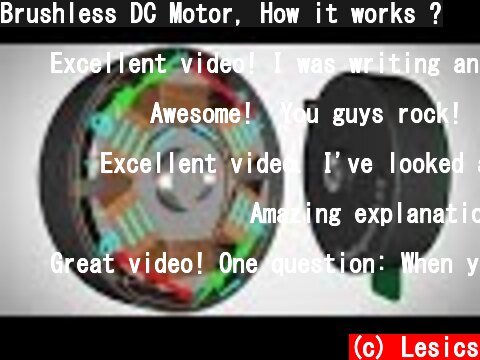
(c) Lesics Help us to make future videos for you. Make LE’s efforts sustainable. Please support us at Patreon.com …
Excellent video! I was writing an article about a controller upgrade for an e-bike with a brushless hub motor, and this is exactly what I was looking for. Unfortunately, it seems the timing is off on the controller I’m using and the coils are energized too long, causing the motor to fight itself and drawing high power at higher RPM. Sort of like a relay race where the runner passing the baton won’t let go soon enough! Thanks again for the video.
Awesome! You guys rock! Thanks for making this and sharing it with the world on Youtube! Really helps me study my EE.
Excellent video. I’ve looked all over for a video that can easily explain the difference between brushed and brushless motors, and you have done so perfectly. It makes perfect sense now! Thank you!
Amazing explanation and animation at the same time. The optimum way of teaching.
Great video! One question: When you have everything connected, do you leave the third coil floating, or what way to you make sure, which way the current runs?
Sensacional! Simplesmente incr�vel explica��o!
Nice video. I have a simple question: how do you tell the direction of the rotation? Would it rotate the opposite direction if at the beginning you rotated the coils 90 degrees clockwise?
Thanks for producing such videos that enable a layman to understand the basics.
Thanks for another class my teacher.Thank you for sharing your time and knowledge …
Excellent presentation, and contained quite a few details I didn’t know. Thank you.
Brilliant work guys…I loved each electrical and mechanical videos you made…thank you and keep up your excellent work.
just to say, your channel is great. It helps a lot to quite understand how this components work, not just to understand but to visualise them. Great work and keep it up. (y)
Wow all this time I’ve been studying this and in three minutes I got it. Thank you this video is a huge help
it is well explained in a simple way ! I have been searching for months something that explains it simply , and it is the only video that is clear and simple to understand, just knowing the basic stuff (opposite poles attract, coils crossed by an electric current create a magnetic field, and just it i think ?)
0:21� DC, �1:15 BLDC, �2:35 3-phase, 4:07 hall SensorThanks.
Great video! One question though:@2:59 you state that the torque will be constant with the shown phase energize algorithm (six-step commutation).For most BLDCs this will not be the case because there will be some kind of torque ripple: https://www.analog.com/en/technical-articles/brushless-dc-motors-introduction-for-next-generation-missile-actuation-systems-outline.htmlorhttps://www.mathworks.com/videos/motor-control-part-4-understanding-field-oriented-control-1587967749983.htmlAs a suggestion, you could show the difference in space vector modulation compared against six-step for a smooth motor control.Don’t get me wrong here: This video is made for folks that want to get in touch with BLDCs alltogether so please just see this as a suggestion from a fellow engineer 😉
Hi, great video thank you. However, I have a question. Why is it that when the rotor nears coil C, coil A gets energised with the opposite polarity? What about the other 3 coils (unlabelled with letters)?
Finally a well made video explaining these motors. Thank you!
Simple yet beautiful explanation. You made my day !
thank you so much, your videos always save me many time! I think it works the same for everyone else to. Nice work!
How does an Alternator Work ?
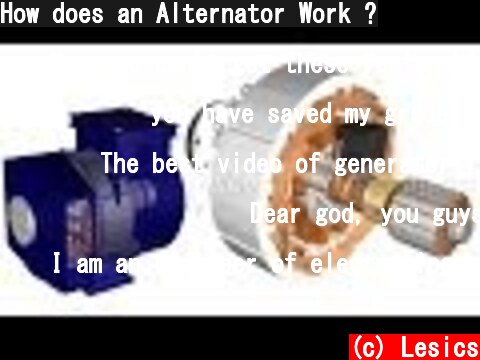
(c) Lesics Help us to make future videos for you. Make LE’s efforts sustainable. Please support us at Patreon.com …
Man you can’t get these feels while reading the books and it’s pretty hard to imagine thanks for animation now it is easy to imagine.
you have saved my grades for the first year of uni! These videos are absolutely fantastic and so clear and easy to understand! thank you sir so so so very much
The best video of generator illustration I ever seen, this video really helps a lot for me to understand how a 3-phase generator works. Thanks!!!
Dear god, you guys are like saints. I understood Alternator better from this one video than my professors 100 minute lectures. My basic understandings became very clear and I did the maths from my text book. I got an exam on this tomorrow and hopefully I will ace it. 🙂
I am an engineer of electronics. Spontaneously it came into my mind and heart that it’s my duty to like and appreciate your fabulous work( i am little busy and lazy too ). truly you made a fine video.
Very good explanation on the principles of an alternator, thank you.
Great video. Greater detail then all the others. Had one question. Are the magnetic lines of flux “flowing” in the correct direction on the rotor windings?They appear to be south to north instead of north to south.
Really great animation work! Learned a lot from this channel. Wow!
Excellent video.� Before watching this video I didn’t understand how the windings were physically laid out in the stator and rotor, but now it is very clear.� Great job!
great video, is there any connection between voltage regulation (or terminal voltage change) and Armature reaction?
Such a beautiful explanation as compared to others till now I have seen .Thank U for teaching so transparently.
Nice video. I believe that, if you view 01:28 of the video, the rotating field has poles at 9 o’clock labelled as “NORTH” and 12 o’clock labelled “SOUTH”, but the winding direction is the same viewing the pole face: this seems to be a contradiction of the right-hand-rule; the winding directions should be opposite on the adjacent poles.
Thank you for producing this very helpful guide to the inner workings of alternators.
You are Doing Great Work Sir . Thankyou So Much. Very Helpful Videos. With the help of these videos, anyone can easily understand the principle and working of important Electrical Engineering topics. May God Bless You.
I’ve learned more in this 5 minute video than I have after hours of reading my textbook. THANK YOU
Fantastic explanation, simple and concise. Thank you
Thanks for this animation.it has helped me a lot.can someone please tell me how the different poles are created on each dc winding of the rotating field?which rule to apply to know the direction of the flux?assuming the green arrows as the direction of the current around the coil,and applying right hand thumb rule,I don’t get similar result for the direction of the flux as shown.thanks in advance
Sir great video, very helpful, can you please also explain how exactly dc current is produced for excitation of rotor.
Thank you for sharing this information. Hope by your next animation you’ll shown the step by step the arrangement of the armature winding 3 phase generator and 3 phase motor and its wiring conection with explanation.
Thank you for sharing this information. Hope by your next animation you’ll shown the step by step the arrangement of the armature winding 3 phase generator and 3 phase motor and its wiring conection with explanation.
How does the INTERNET work? | ICT #2
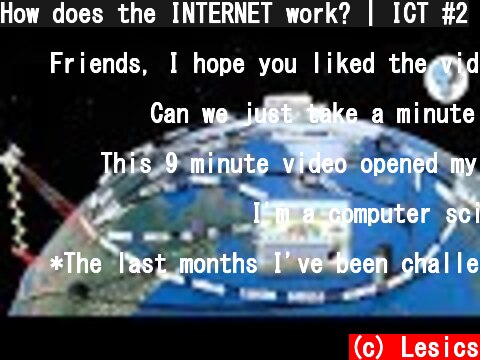
(c) Lesics How does the Internet work? The video you are watching now traveled thousands of miles from a Google data center to reach you.
Friends, I hope you liked the video. https://www.patreon.com/LearnEngineering , Your support at Patreon is invaluable to us.
Can we just take a minute to appreciate this amazing animation?
This 9 minute video opened my eyes and blew my mind. Almost 20 years of using computers and 2 years of IT education wasn’t enough.
I’m a computer science student and this video teach my whole year of school lesson in less than 10mins
*The last months I’ve been challenging YouTube’s algorithm. I’m staring to understand that we’re running in circles!* 🤯
Just found this channel recently… The way they explain things with a simple verbal and animations makes me learn new things in an easy way. This is the best channel to learn new things…. Thank you guys for these valuable efforts 🙏
very nice video, much appreciated, thank you 🙂
That is so beautifully put, amazing content. Learned a lot to teach new contents to my students and channel viewers!❤️
Incredible animation! This has to be the best video out there explaining how internet works. It would be awesome if you could make a video diving deeper into the protocols for data transfer
I find it amazing that even an explanation like this, people still think it runs off of magic after ive told them multiple times how it works.
This video was extremely well animated and the explanations given were easily understandable. I’m still shocked how far technology has come in such a short period of human history.
Today , I will respect my super slow internet connection 😇
This video taught me better than my professors did. Awesome content🤩
An excellent explanation with an awesome presentation. Really surprised to realize how fast will be the switching of data reception channel happens when we disconnect a device from our home WiFi and connct to cellular data while watching the same video. Rest of same packet stream is transmitting along an entirely different path in fraction of second. Amazing!!!
This was such an amazing video. The explanation was simple and the visuals were really helpful in showing you how everything is working together.
This was so simple and so great, we have come such a long way as a species.
This is truly amazing ! A big applause to all those geniuses who invented Internet !!
This is the most clear cut and to the point explanation of Internet working. Brilliant work👍
Oh Man, this is the best tutorial I have ever come across about internet especially for a layman like me.. Thanks and lot of appreciation for the work done.. 👍👍👍
This is an amazing explanation. Keep it up for us to learn more in this non complex method.
How does your mobile phone work? | ICT #1

(c) Lesics For most of us, a mobile phone is a part of our lives, but I am sure your curious minds have always been struck by such questions …
Learning is not hard; it is just our damn schools which makes it hard to understand. Thank you for the amazing demonstration
In all seriousness, this is amazing, to think how quick how it takes to process your communication, not to mention how many people it caters for, actually amazing and something we take for granted
Remember learning this 15 years ago as part of an MSc in Telecommunications 🙂 Cell towers are also called base stations and the professor (lovely gentleman) who taught this course pronounced it base-is-station … in a 90 min lecture that is a lot of base-is-stations — and thanks to that I never forgot the lecture …brings back fond memories 🙂
First time ever i found a channel on which i can really learn things. The real engineering. How ever concepts are very clear but not at it’s base for which books are required.But you guys are really good at it.Keep it up guys.I’m eagerly waiting for other videos as I’m gonna download all of the videos with in 2-3 days.Thanks for your efforts.
Awesome job!! You did a great job at explaining so many rather complex concepts! I really liked the details about the MSCs and hexagonal cells. Keep up the great work.
I retired from a phone company and this is very high level, but still one of the best explanations I’ve ever seen. Good job!
This is amazing. We take this for granted but look how complicated it is. This is miracle to me.
this was a quick and efficient revision for my 8th semester subject Mobile computing. Working with routers and switches professionally as a Network Engineer had me losing my grip on the subject. Thanks for the video!
Lets spend a minute to respect and appreciate the people who have done tremendous amount of work to provide such a miraculous technology..🙏🏻🙏🏻🙏🏻👏🏻👏🏻👏🏻
We must thank such a person who has made this animation Thanks bro 😀
I agree…. In schools, and online we had tons of lengthy pages to learn these technologies, spent so much of time but still confuses and hard to understand. This video is awesome, It explained the mobile technology so beautifully
This video explained better than my bachelor’s degree in the IT…. honestly, after the graduation, I was still very clueless about all this information traveling functionality but this video explained everything for me
A great video on cellular radio. I have questions about necessary equipment to provide additional spectrum for increased service demand. I’m curious about how cell companies can add equipment so seemingly easily in such short order. I’ve been reading about how AT&T and T-Mobile are going to be using spectrum loaned by other spectrum holders – so that demand for data precipitated by Coronavirus concerns can be met. How do they do this so rapidly?
Hi.Thanks a lot to make us understand the working process of most of things..Your vdos have made the understanding 10 times easier and simple. .
Great presentation and knowledge. Thank you for your time and effort and look forward to other great videos ✌
omg!!!!! your explanation can be understood by a toddler also. thanks a ton!!!continue making many more such informative videos…………….I had taken up a course on Coursera but cldnt really understand a few things but these series make things so cool n easy
Thank you for such a specific and elaborate explanation. This is the only video that answered all my questions in one!
you guys are doing a great job , by making amazing animation videos
It’s interesting to know how much technology goes behind just making simple phone call!
Content is really good and well explained, May I know the Software used for animations , it will be reallyyyy helpful for my students too. Thanks
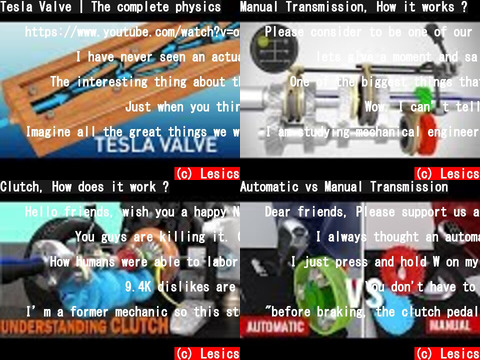













![岡田斗司夫 [切り抜き] 編集ちゃんねる(Youtube 動画 pick up)](https://imitoha.com/c/imgc/UCwfyW7i8kAFUj8_tSSDT_PA/-a-input.jpg)









コメント